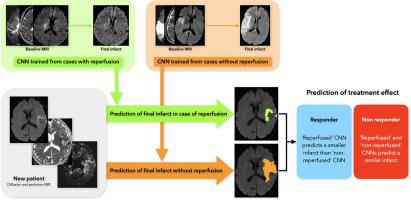NeuroImage: Clinical ( IF 4.2 ) Pub Date : 2020-12-25 , DOI: 10.1016/j.nicl.2020.102548 Noëlie Debs 1 , Tae-Hee Cho 2 , David Rousseau 3 , Yves Berthezène 4 , Marielle Buisson 5 , Omer Eker 4 , Laura Mechtouff 6 , Norbert Nighoghossian 2 , Michel Ovize 7 , Carole Frindel 1

|
Background
Predictive maps of the final infarct may help therapeutic decisions in acute ischemic stroke patients. Our objectives were to assess whether integrating the reperfusion status into deep learning models would improve their performance, and to compare them to current clinical prediction methods.
Methods
We trained and tested convolutional neural networks (CNNs) to predict the final infarct in acute ischemic stroke patients treated by thrombectomy in our center. When training the CNNs, non-reperfused patients from a non-thrombectomized cohort were added to the training set to increase the size of this group. Baseline diffusion and perfusion-weighted magnetic resonance imaging (MRI) were used as inputs, and the lesion segmented on day-6 MRI served as the ground truth for the final infarct. The cohort was dichotomized into two subsets, reperfused and non-reperfused patients, from which reperfusion status specific CNNs were developed and compared to one another, and to the clinically-used perfusion-diffusion mismatch model. Evaluation metrics included the Dice similarity coefficient (DSC), precision, recall, volumetric similarity, Hausdorff distance and area-under-the-curve (AUC).
Results
We analyzed 109 patients, including 35 without reperfusion. The highest DSC were achieved in both reperfused and non-reperfused patients (DSC = 0.44 ± 0.25 and 0.47 ± 0.17, respectively) when using the corresponding reperfusion status-specific CNN. CNN-based models achieved higher DSC and AUC values compared to those of perfusion-diffusion mismatch models (reperfused patients: AUC = 0.87 ± 0.13 vs 0.79 ± 0.17, P < 0.001; non-reperfused patients: AUC = 0.81 ± 0.13 vs 0.73 ± 0.14, P < 0.01, in CNN vs perfusion-diffusion mismatch models, respectively).
Conclusion
The performance of deep learning models improved when the reperfusion status was incorporated in their training. CNN-based models outperformed the clinically-used perfusion-diffusion mismatch model. Comparing the predicted infarct in case of successful vs failed reperfusion may help in estimating the treatment effect and guiding therapeutic decisions in selected patients.
中文翻译:

再灌注状态对使用深度学习预测最终卒中梗塞的影响
背景
最终梗死的预测图可能有助于急性缺血性中风患者的治疗决策。我们的目标是评估将再灌注状态整合到深度学习模型中是否会改善其性能,并将其与当前的临床预测方法进行比较。
方法
我们对卷积神经网络(CNN)进行了培训和测试,以预测在我们中心通过血栓切除术治疗的急性缺血性中风患者的最终梗塞情况。在训练CNN时,将来自非血栓切除术队列的未再灌注患者添加到训练集中以增加该组的人数。将基线扩散和灌注加权磁共振成像(MRI)用作输入,在第6天MRI上分割的病变是最终梗死的基础。将该队列分为两部分,再灌注和非再灌注患者,从中发展出再灌注状态的特定CNN并与彼此进行比较,并与临床使用的灌注-扩散不匹配模型进行比较。评估指标包括骰子相似性系数(DSC),精度,召回率,体积相似性,
结果
我们分析了109例患者,其中35例未进行再灌注。当使用相应的再灌注状态特异性CNN时,再灌注和未再灌注患者均达到最高DSC(分别为0.44±0.25和0.47±0.17)。与灌注扩散失配模型相比,基于CNN的模型获得了更高的DSC和AUC值(再灌注患者:AUC = 0.87±0.13 vs 0.79±0.17,P <0.001;未再灌注患者:AUC = 0.81±0.13 vs 0.73±在CNN与灌注扩散不匹配模型中分别为0.14,P <0.01)。
结论
将再灌注状态纳入其训练后,深度学习模型的性能得到改善。基于CNN的模型优于临床上使用的灌注-扩散不匹配模型。预测的梗塞中的成功情况相比VS失败再灌注可能有助于在估计治疗效果和引导在选定的患者的治疗决定。



























 京公网安备 11010802027423号
京公网安备 11010802027423号